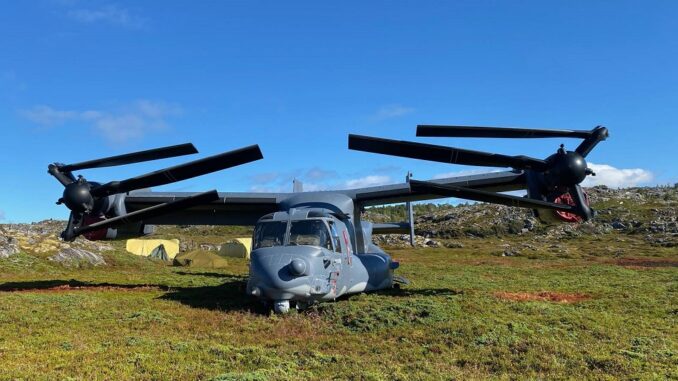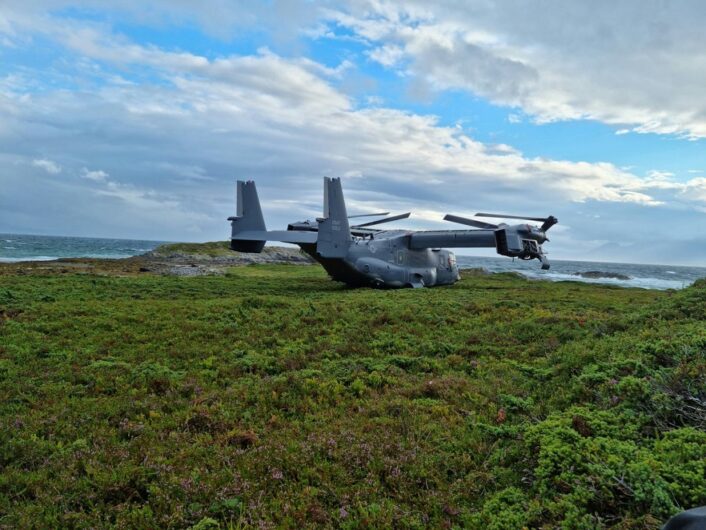[ad_1]

The Norwegian Armed Forces and the U.S. Air Force are still working on a plan to recover the aircraft without damaging the wildlife in the Stongodden reserve.
A CV-22B Osprey tiltrotor aircraft, belonging to RAF Mildenhall’s 352nd Special Operations Wing, has been stranded for a month in the Norwegian wilderness after an emergency landing on Aug. 12, 2022. The aircraft experienced a “hard clutch engagement”, which prompted the crew to immediately land as part of the emergency checklist. However, the Osprey is still stuck at the Stongodden nature reserve on the island of Senja as authorities are working on a plan to recover it.
According to the Air Force Special Operations Command, the CV-22, assigned to the 7th Special Operations Squadron, was involved in a training exercise when the emergency happened. No one was injured after the controlled emergency landing. The incident was the second hard clutch engagement in six weeks, and the command therefore ordered a safety stand-down of its 52 Ospreys.
Hard clutch engagement occurs when the clutch connecting the propeller’s gear box to its engine slips and the Osprey transfers the power load from that engine to the other one, allowing it to keep flying in the event of an engine failure, and then the power load in transferred back to the original engine as its clutch engages again. The large transfer of torque between the two engines within a span of milliseconds throws the aircraft off balance.
AFSOC is investigating whether it is a mechanical, design or software problem causing these hard clutch engagements. “We absolutely owe the air crew information about why this is happening and how we’re going to mitigate it,” said AFSOC public affairs director Lt. Col. Becky Heyse. “Because we don’t have that now, Gen. Slife [AFSOC Commander ndr.] didn’t feel comfortable flying them.” The stand-down has been lifted earlier this month.
Fifteen clutch malfunctions have been reported over the past decade, including four in the Air Force and 11 in the Marine Corps. “Those large, transient torque spikes exceed the limitations of the engines and the gearboxes,” said Lt. Gen. Slife. “Each one of them results in a ‘Christmas tree’ of caution lights in the cockpit and some pretty squirrely flight control inputs.” These malfunctions have often led to the replacement of gear boxes and engines, which qualified them as Class A mishaps.

In the meantime, AFSOC introduced flight restrictions to try to limit situations that could cause hard clutch engagements, like momentarily pausing before throttling up to full power during takeoff and opting to perform roiling takeoffs from runways instead of vertical takeoffs. These restrictions should reduce the stress on the engines and limit torque spikes.
AFSOC wants to dig into the factors shared by each malfunction and eliminate as many as possible. For an instance, almost all of the incidents involved Ospreys with gearboxes that have been flown for a similar number of flight hours. “We’ve all understood that this is an actual mechanical problem. What has eluded us is the root cause – why is the clutch slipping in the first place?” said Lt. Gen. Slife. “My view is, we may not understand why it’s happening, but we absolutely know what is happening.”
The Norwegian Armed Forces worked with the local environmental protection office to plan the recovery of the Osprey from the nature reserve, in collaboration with the U.S. Air Force. Lt. Col. Eivind Byre, a spokesperson for Norway’s military, said to the press that they hope to launch the operation this week. The proposed plan is said to be incredibly complicated and something neither the Norwegian nor the Americans have done before.
The plan involves the creation of a small wooden road that will protect vulnerable wildlife at the reserve without destroying the terrain while the aircraft is moved closer to shore. Once there, a crane-equipped boat will get as close to the Osprey as possible, without running aground in shallow water, and pick it up. A ramp and a jetty will also be built to create conditions favorable for a retrieval by sea.
Disassembling the CV-22 has been ruled out due to concerns of the aircraft becoming unbalanced and toppling over. Lifting it on the boat is not an easy task, as in the current conditions the Osprey weighs about 20 tonnes and, because of the very shallow waters, a 70-metre-long crane arm is being used. The weather introduces more limitations, as there cannot be waves more than 0.3 meters high or winds of more than seven meters per second.
Update 14 sep: Rescuing stuck US Osprey at Stongodden, Senja (North-Norway). A few more pics.. pic.twitter.com/KoZF616v6C
— Selshevneren (@selshevneren) September 15, 2022
The recovery operation which appears to have started on Sept. 14, is expected to last about two to three weeks. In the meanwhile, a 200 meters-wide military zone has been established around the machine, with Norwegian Armed Forces and U.S. Air Force personnel guarding the area.
[ad_2]
Source link
